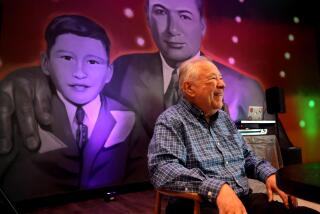More color, please
IN Hollywood, to paraphrase the old James Brown song, it’s a white, white, very white world. Sometimes when I sit in on a production meeting or visit a movie set or have lunch at the Grill I’m struck by the fact that in an industry with an ever-growing roster of African American and Latino actors and filmmakers, the odds of my seeing a black or Latino executive are about as good as seeing a studio chief pumping gas at a truck stop in Wyoming.
Having made movies about multiethnic subjects his entire career, both as a hit director (“Boyz N the Hood,” “Four Brothers” and “2 Fast 2 Furious”) as well as a producer (“Hustle & Flow”), John Singleton knows exactly what it’s like to pitch an idea that revolves around people of color to a roomful of white executives. “Basically the American studio structure is the same as it’s been since Louis B. Mayer and Jack Warner ran the business,” he says. “This is not one of these businesses run by affirmative action. In Hollywood, affirmative action is all about -- how much money can you make?”
After his success bankrolling “Hustle & Flow” with his own money, Singleton is rolling the dice again, having earned a rare opportunity to bypass the stodgy studio greenlighting process and make the kind of movies that reflect an increasingly diverse country. Singleton and Universal Pictures are announcing this week that Universal will market and distribute five films financed and produced by Singleton. Each made for less than $15 million, the films will be distributed either by Universal or its Focus and Rogue divisions. The importance of the deal is that the studio has agreed to release the finished pictures; all the creative decisions are made by Singleton.
The first film in Universal’s agreement with Singleton’s New Deal Productions is “Illegal Tender,” a family drama about a young man and his mother who try to escape the drug-fueled violence of their old neighborhood in the Bronx. Directed by Franc Reyes, it is now filming in New York and Puerto Rico. Singleton is providing the funding for the $8-million picture, while lining up money for future projects.
It’s clear that the new slate of films will reflect Singleton’s interests as a filmmaker, which have evolved from such personal projects as “Rosewood” to more genre-oriented films such as “Four Brothers” and “Shaft.” “If you make a movie for less than $15 million with the right genre elements and a young, multiethnic cast, you can make a nice profit,” he says. “These aren’t movies where people are sitting around talking all the time. Franc’s film is a lot like ‘Scarface,’ but with a Latino mother and son. It’s got a lot of heart, but Franc jokes that whenever he sees me, I’m going, ‘Can’t we have more guns in this shot?’ ”
Singleton says he approached Paramount Pictures, which released “Hustle & Flow,” but the studio wasn’t interested in a deal. Universal was a perfect fit, not only because the studio has already made a number of multiethnic pictures, but because Singleton has a close relationship with new Universal Chairman Marc Shmuger.
“I’ve known Marc for 16 years and I consider him a friend,” Singleton says. In fact, “Boyz N the Hood” was the first picture Shmuger worked on when he came to Sony in 1991 as an advertising executive. When Shmuger later moved to Universal, he worked with Singleton on “2 Fast 2 Furious.”
“From the very beginning of his career, John has crossed over to all kinds of audiences,” Shmuger says. “He’s always stood out as someone who’s not only in touch with the youth culture, but who has a great eye for casting and finding new talent. It’s no secret that our industry is badly in need of discovering fresh actors and filmmakers, and we expect that John will be a bridge to help us connect with them.”
Shmuger is especially excited about reaching the Latino audience, which he says is the fastest-growing demographic in the country. (Latinos were a big force behind “Nacho Libre’s” $27.5-million opening this past weekend.) “They way over-index for moviegoing, so they’re going to be an increasingly big force in pop culture. They come to the broad-based movies we make, but we haven’t been successfully focused on creating the movies that speak to them, which is what John’s trying to do.”
Singleton, who studied film at USC, sees a historical link between today’s Latino moviegoers and the immigrants who made up the bulk of the moviegoing audience in the industry’s early nickelodeon era. “The first great boom in American cinema was fueled by the immigrants from Europe who didn’t speak English, but went to the movies in droves in the early 1900s,” he explains. “It’s totally analogous to the millions of cool young bilingual Latinos who go see ‘Saw’ and ‘The Fast and the Furious’ and the youth comedies. They drive a big chunk of the box office.”
The problem, as Singleton sees it, is that Hollywood isn’t always comfortable with new faces from unfamiliar cultures. Reyes’ last film, “Empire,” was a low-budget hit in 2002. But he hasn’t directed a film since. When I asked Singleton why, he answered: “He’s almost 6 feet tall, he’s Puerto Rican and he’s opinionated. Being Puerto Rican has made it tougher for him, no doubt.”
Wouldn’t Hollywood do a better job of creating movies that speak to this multiethnic audience if the studio executive suites weren’t so lily white? It’s an especially embarrassing question for the film industry, which is full of supporters of all sorts of progressive causes, but when it comes to hiring people of color, betrays a huge gap between its ideals and its actions.
“Forget about what’s right, if you’re dealing with a pop culture that’s so driven by Latinos and African Americans, you’d think it would just be good practice to have people of color in those jobs,” says Spike Lee, who’s been a longtime advocate of improved Hollywood minority hiring practices. “But when they are making the big decisions, about greenlighting movies and TV shows, we’re not participating.
“I’ve been meeting with executives who can make movies for 20 years and I’ve never sat across the table from someone who looked like me. When I do see a young black face, I think -- did they pull ‘em in from the mailroom? It’s like they have someone in a glass case on the shelf that says, ‘Break the glass in case Spike Lee comes into the room!’ ”
The head count is pretty dismal. A survey of African American or Latino production executives at a vice president level or higher found one executive at 20th Century Fox, New Line and Paramount, none at Universal, Warner Bros. and Sony Pictures. After three days of trying, I couldn’t get an answer out of Disney’s corporate publicity staff, so I’m guessing they’re at zero too. Whenever I would ask studio chiefs for an explanation, there was usually a long, awkward silence.
“We haven’t done a good enough job to get better representation of African Americans and other minorities inside the company,” Shmuger says. “Obviously this partnership with John is a big step forward in terms of bringing in more diverse points of view. But it’s a fair criticism. We’ve got a long way to go.”
20th Century Fox Co-Chairman Jim Gianopulos says, “It’s not for lack of interest or desire, because we’re constantly searching for creative people. But it’s a really difficult question and we haven’t found an answer yet.”
Some executives believe progress is being made, even if it is painfully slow. “I think if you look at our company or at the talent agencies, you’re starting to see more faces of color,” says New Line production chief Toby Emmerich. “This certainly isn’t something that’s under the radar with our human resources department.”
What the studio executives won’t say, at least on the record, is that it isn’t easy to attract minority talent to the studio system. This is in part because studios are an incredibly insular world, but also because minorities don’t necessarily see the job of studio employee as such an enviable goal in an era where the real action is in new technology, hip-hop and other more entrepreneurial, ownership-oriented arenas.
Much of the creative energy today is on the outside of corporate systems, not the inside. “John isn’t going to put on a suit and go to the office,” says Shmuger, adding with a laugh, “He knows he has a better job than me.”
In the music business, for example, a variety of black artists and producers have successfully made the leap to running record labels, including Sean “Diddy” Combs, Dr. Dre, L.A. Reid, Jermaine Dupri and Jay-Z. Singleton sees Jay-Z as an intriguing role model.
“I want to do for the movie business what Jay-Z did in the music business,” he says. “He’s the guy everyone goes to for guidance, which is a role I want to embrace, being a godfather to a new generation of filmmakers.”
Hip-hop has remained relevant, Singleton says, because it is always embracing new talent. “The studios are always two years behind,” he says. “They say they want to be in the new talent business, but if you’re sitting at Morton’s, you’re not out helping a young filmmaker learn how to fix their script or get a shot right.”
At 38, Singleton may not be as young or brash as he once was, but he still knows talent when he sees it. And talent attracts money, which is one thing the executives in the white world of today’s studios understand. “I want to nurture the next generation, which is where our future will come from,” Singleton says. “I’m hoping I can give them what I always wanted, which is some real-life advice.”
“The Big Picture” runs every Tuesday in Calendar. If you have questions or criticism, e-mail them to patrick.goldstein @latimes.com.
More to Read
The biggest entertainment stories
Get our big stories about Hollywood, film, television, music, arts, culture and more right in your inbox as soon as they publish.
You may occasionally receive promotional content from the Los Angeles Times.










